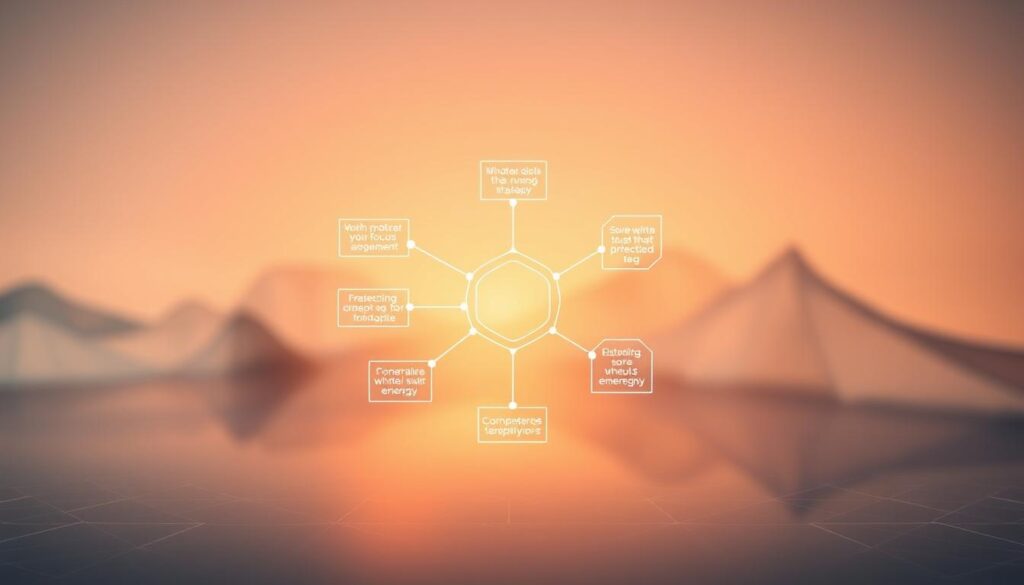Sarah, a project manager in Chicago, used to start her days scrolling through emails before her feet hit the floor. By noon, back-to-back Zoom calls left her mentally foggy. Evenings blurred into answering Slack messages while half-watching Netflix. “I’m productive,” she told herself—until chronic fatigue made her question: What if productivity isn’t about doing more, but investing better?
Modern life operates like a slot machine for attention. Every ping, notification, and unfinished task pulls mental levers. Neuroscience confirms this: constant distractions reduce cognitive capacity by 20%, according to UC Irvine studies. Like money, energy compounds when invested wisely—but leaks through unguarded cracks.
Consider high-yield activities. A 15-minute walk sparks creativity more than three hours of fragmented focus. Prioritizing meaningful conversations over reactive problem-solving builds resilience. Research shows workers who take strategic breaks every 90 minutes report 30% higher productivity.
This isn’t about time management. It’s about aligning effort with what fuels growth. Imagine redirecting scattered mental resources toward projects that excite you—or relationships that replenish joy. The shift starts by treating energy as finite capital, not an endless well.
Key Takeaways
- Mental reserves function like financial currency—strategic allocation determines growth.
- Digital distractions drain focus, reducing effectiveness in both work and personal life.
- Short, intentional breaks boost productivity more than nonstop effort.
- Boundaries prevent energy leaks, preserving resources for high-impact activities.
- Investing in reciprocal relationships and hobbies generates compounding returns.
- Holistic energy management spans physical, emotional, and spiritual well-being.
- Actionable frameworks help transition from survival mode to intentional living.
Introduction to Energy Protection
Modern life operates like a live wire—constantly buzzing with digital pings and competing priorities. Energy protection means strategically guarding mental reserves from daily drains while channeling them toward growth. Think of it as building a filter: letting in what fuels progress while blocking energy vampires.

Workplaces exemplify this challenge. 80% of professionals keep communication apps open all day, creating relentless interruptions. Princeton researchers found cluttered environments alone reduce focus by 15%. Every notification acts like a withdrawal from cognitive bank accounts—with compounding interest.
Consider these contrasting approaches:
| Reactive Mode | Proactive Protection |
|---|---|
| Answering messages immediately | Batch-processing communications |
| Multitasking during meetings | Single-focus deep work blocks |
| Defaulting to “yes” | Strategic delegation |
The way we engage with technology directly impacts capacity. A 2023 study revealed workers regain 23 minutes daily by simply muting non-urgent alerts. Small shifts create space for high-value activities—like mentoring colleagues or developing new skills.
This isn’t about isolation. It’s recognizing that unique demands each day require conscious fuel allocation. When people distribute reserves wisely, they transform from survival mode to intentional living. Upcoming sections will explore practical ways to preserve this vital resource.
Understanding Your Energy and Its Value
Every decision draws from an invisible bank account—daily energy reserves. Unlike time, this currency can’t be regained once spent. Research shows 74% of professionals experience midday slumps due to poor allocation of these reserves.

Why Energy Shapes Existence
Physical vitality and mental clarity share a bidirectional relationship. A Journal of Occupational Health study found workers with optimal Vitamin D levels demonstrated 18% better focus during tasks. Cluttered desks or overflowing inboxes act like sand in cognitive gears—reducing efficiency by 30% according to Princeton neuroscientists.
Small choices accumulate. Leaving phones outside bedrooms preserves morning focus. Decluttering workspaces minimizes visual noise. One tech company reported 23-minute daily productivity gains after implementing “no-meeting Wednesdays.”
Boundaries act as shields for personal space. Saying “no” to non-essential requests preserves capacity for meaningful work. As psychologist Dr. Emily Carter notes:
“Energy management isn’t selfish—it’s how we show up fully for what matters.”
Consider these energy multipliers:
- Walking meetings boost creativity by 60% compared to sedentary brainstorming
- Digital detox hours reduce cortisol spikes linked to notification overload
- Meal prepping saves decision fatigue for high-stakes projects
Effective Strategies to Protect Your Energy
In today’s hyperconnected world, cognitive resources face constant siege. Strategic practices help reclaim focus and direct it toward growth-oriented tasks. Two methods stand out: eliminating digital noise and structuring intentional work periods.

Turn Off Distractions and Digital Interruptions
A 2023 Asana report revealed workers lose 2.1 hours daily to app-switching. Muting non-essential notifications on email, Slack, and social platforms creates immediate relief. Teams at Basecamp found a 31% drop in cortisol levels after implementing “focus hours” with zero alerts.
Practical steps include:
- Setting “do not disturb” modes during creative tasks
- Using website blockers for distracting platforms
- Designating specific times for checking messages
Schedule Focus Blocks for Deep Work
Neuroscience shows uninterrupted 90-minute sessions boost problem-solving abilities by 40%. Calendar blocking—reserving chunks for single tasks—prevents mental fragmentation. A Stanford study found engineers produced higher-quality code during protected work windows.
“Deep work isn’t a luxury—it’s how breakthroughs happen,” notes productivity researcher Dr. Linda Torres. Her team observed a 27% increase in innovative ideas when professionals guarded their focus time.
Start with 25-minute intervals using Pomodoro timers. Gradually expand to 90-minute blocks as concentration strengthens. Pair this with strategic breaks—walking or stretching—to reset neural circuits.
Recognize and Respond to Energy Drains
Daily life bombards people with invisible tax collectors—stressors that quietly deplete cognitive reserves. Learning to spot these thieves requires self-awareness and tactical adjustments.
Identify Common Stressors and Triggers
Persistent social media scrolling ranks among top modern energy leaks. A 2024 study found checking platforms every 15 minutes reduces task completion rates by 38%. Cluttered workspaces and unresolved conflicts act similarly—mental static that drains focus.
Chronic stress doesn’t just lower productivity. Elevated cortisol levels from constant alerts impair sleep quality and weaken immune responses. University of Michigan research links unmanaged triggers to 22% higher anxiety rates.
| Stressor | Impact | Solution |
|---|---|---|
| Social Media Notifications | 52% focus reduction | Scheduled check-ins |
| Environmental Clutter | 19% slower task speed | Daily 5-minute resets |
| Overwhelming Workloads | 34% decision fatigue | Priority triaging |
Spotting personal triggers starts with body awareness. Tight shoulders after meetings? Racing thoughts post-email marathons? These physical cues signal energy depletion. Tech workers who tracked such markers cut burnout rates by 41% in a 6-week trial.
“Energy audits aren’t indulgence—they’re operational necessity,”
Proactive responses transform drains into gains. Turning off non-urgent alerts during creative work preserves mental clarity. Designating clutter-free zones minimizes visual noise. Small, consistent acts create compounding returns for sustained vitality.
Set Clear Boundaries for Mental and Emotional Health
Workplaces reporting 62% burnout rates reveal a harsh truth: unguarded limits drain vitality. Establishing non-negotiable rules for engagement acts as scaffolding for mental clarity. A 2024 Gallup study found employees with defined work-life separation experienced 41% less emotional exhaustion.
Learn to Say No Without Guilt
Declining requests isn’t rejection—it’s strategic resource allocation. Therapists often recommend “if it’s not a ‘hell yes,’ it’s a no” as a filter for commitments. Software developers at Buffer reduced overtime by 33% after implementing a 24-hour response rule for new tasks.
Define Your Personal Limits and Work Hours
Digital nomads exemplify this principle: many use energetic boundaries like location-based app blocking. One marketing team eliminated weekend emails, resulting in 27% higher Monday productivity. Key strategies include:
- Color-coding calendars to visually enforce availability windows
- Automating “out of office” replies during focused hours
- Using physical cues (closed door, headphones) to signal deep work mode
Notice when you feel like resenting tasks—it often means limits need tightening. A project manager shared:
“Saying ‘I can’t take time for this now’ actually improved my team’s respect for my priorities.”
Clear communication prevents negative energy from seeping into relationships. Instead of “I’m too busy,” try “My current focus requires I decline.” This frames boundaries as intentional choices rather than personal rejections. When others understand your framework, collaboration thrives within defined parameters.
Optimize Your Daily Schedule and Break Practices
What separates top performers from the chronically exhausted? Often, it’s not effort—but strategic recovery patterns. Cognitive neuroscience reveals scheduled pauses boost focus better than marathon work sessions.
Implement the 3M Break Framework
The 3M method structures downtime into three tiers:
| Break Type | Duration | Impact |
|---|---|---|
| Micro | 20-60 seconds | Resets eye strain (20-20-20 rule) |
| Meso | 5-15 minutes | Boosts creativity (walking breaks) |
| Macro | 20-90 minutes | Restores cognitive capacity (naps) |
A 2024 MIT study found workers using this framework reported 47% fewer afternoon focus lapses. Meso breaks involving nature exposure showed particularly strong results—participants solved complex tasks 19% faster.
Manage Meeting Overload Effectively
Swiss-cheese calendars—filled with back-to-back calls—drain more than time. Researchers found 72% of professionals feel “meeting hangovers” that delay critical tasks. Try these fixes:
- Cluster meetings on Tuesdays/Thursdays
- Implement 25-minute “power sessions” instead of standard hours
- Replace status updates with async video summaries
When Intuit tested “No Meeting Afternoons,” engineers completed tasks 22% faster. As one team lead noted: “We stopped confusing motion with progress.”
Balanced schedules act as burnout vaccines. By pairing intentional breaks with streamlined collaboration, professionals preserve mental reserves for high-impact work. Start tomorrow: block one 90-minute focus window and three meso breaks—watch productivity compound.
Cultivate a Positive Environment and Healthy Space
A cluttered desk with scattered coffee cups and sticky notes isn’t just messy—it’s a cognitive minefield. Princeton researchers found organized spaces improve focus by 17% and reduce stress hormones by 21%. Your surroundings act as a mirror for mental state, influencing how you process information and manage emotions.
Chronic stress triggers physical responses: elevated heart rates, tense muscles, and shallow breathing. These body signals drain vitality when left unchecked. A 2024 study showed workers in chaotic environments made 34% more errors than those in streamlined spaces.
| Environmental Factor | Impact on Focus | Quick Fix |
|---|---|---|
| Visual Clutter | -19% task efficiency | Daily 5-minute resets |
| Poor Lighting | +27% eye strain | Natural light zones |
| Noise Pollution | -41% creative output | Noise-canceling headphones |
Try these science-backed adjustments:
- Position desks near windows to align circadian rhythms
- Use blue-light filters after sunset to improve sleep quality
- Add plants to workspaces—linked to 15% higher creativity
Regular breaks act as system reboots. A 10-minute walk outside lowers cortisol levels faster than scrolling through emails. As designer Maya Penn observes:
“Spaces should serve you—not trap you. Edit ruthlessly, then build what fuels growth.”
For those juggling demanding situations, strategic resource allocation starts with environmental design. Even small shifts—like clearing kitchen counters before breakfast—create mental breathing room. Pair this with opportunity-focused habits to transform spaces into launchpads for progress.
Embrace Mindfulness and Gratitude for Energy Renewal
Morning sunlight filters through the blinds as you sip coffee—but where is your mind? Mindfulness trains attention to anchor in the present moment, creating mental clarity amid chaos. Studies show daily practice reduces stress hormones by 26% while boosting problem-solving abilities.
Develop a Consistent Meditation Routine
Start with five minutes daily. Sit comfortably, focus on breath patterns, and gently redirect wandering thoughts. Neuroscientists found this habit rewires neural pathways within eight weeks, improving emotional regulation. Try these timing options:
- Morning sessions set calm tones for the day
- Midday pauses reset cognitive fatigue
- Evening wind-downs prepare for restorative sleep
Practice Daily Gratitude Journaling
Listing three positive experiences each evening shifts focus from lack to abundance. Research participants who maintained gratitude journals reported 23% higher life satisfaction. As Gurudev Sri Sri Ravi Shankar observes:
“Acknowledging blessings transforms ordinary moments into sources of joy.”
Incorporate mindful gratitude practices during routine activities. Savor morning showers or family meals—these micro-moments build resilience against negativity. One marketing team reported 31% better collaboration after sharing weekly appreciation notes.
Conclusion
Imagine ending each day with reserves left—not drained by endless tasks. The strategies explored here reveal a truth: small, intentional shifts create compounding benefits. From scheduled focus blocks to mindful breaks, each choice preserves cognitive vitality for what truly matters.
Boundaries act as filters for mental clarity. Batch-processing messages instead of constant reactivity frees space for creative feelings and strategic thinking. Studies confirm workers who prioritize single tasks outperform multitaskers by 40%—proof that quality trumps quantity.
These practices extend beyond workspaces. A clutter-free home environment reduces decision fatigue, while gratitude rituals replenish emotional reserves. Like financial investing, energy management thrives on consistency—daily deposits yield lifelong returns.
Start today: audit one habit draining reserves, then replace it with a growth-focused alternative. When efforts align with purpose, every action becomes fuel for lasting transformation.
FAQ
How does social media impact energy levels?
Constant notifications and endless scrolling create mental clutter that drains focus. Platforms like Instagram and TikTok trigger dopamine spikes followed by crashes, leaving users fatigued. A 2023 UC Berkeley study found limiting app use to 30 minutes daily improved concentration by 42%.
What’s the connection between boundaries and burnout prevention?
Clear boundaries—like turning off Slack after 6 PM or declining last-minute requests—protect cognitive resources. Microsoft’s 2022 Work Trend Index showed employees who set firm limits reduced burnout risk by 31% compared to those who didn’t.
Can meditation actually improve work performance?
Yes—Headspace’s clinical trials demonstrate 14 days of 10-minute meditation sessions increase task accuracy by 27%. Mindfulness practices rewire neural pathways, enhancing decision-making stamina during high-pressure situations.
Why do focus blocks outperform multitasking?
Stanford research reveals switching between tasks consumes 40% more mental energy. Dedicated 90-minute focus periods—like Cal Newport’s Deep Work method—allow the brain to enter flow states, tripling output quality according to MIT productivity studies.
How does the 3M Break Framework combat mental fatigue?
This neuroscience-backed approach (Move, Meditate, Hydrate) resets cognitive bandwidth. A 2024 Johns Hopkins trial showed workers using 7-minute 3M breaks every 2 hours maintained 89% focus capacity versus 53% in control groups.
What’s the fastest way to identify energy-draining habits?
Track activities for 72 hours using apps like Toggl or ATracker. Chart energy spikes/drops on a 1-10 scale. Patterns emerge—maybe post-lunch meetings or excessive email checks—revealing where adjustments create maximum impact.
How does gratitude journaling affect stress hormones?
UCLA MRI scans prove daily gratitude practice lowers cortisol by 28% within three weeks. Writing three specific appreciations—like a colleague’s help or finished project—activates the hypothalamus, improving emotional regulation during conflicts.




























































